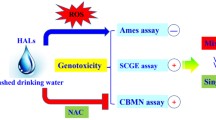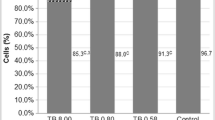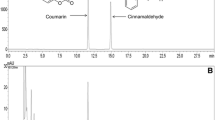Abstract
Purpose
Ciprofloxacin (CIP), a broad-spectrum, second-generation fluoroquinolone, has frequently been found in hospital wastewaters and effluents of sewage treatment plants. CIP is scarcely biodegradable, has toxic effects on microorganisms and is photosensitive. The aim of this study was to assess the genotoxic potential of CIP in human HepG2 liver cells during photolysis.
Methods
Photolysis of CIP was performed in aqueous solution by irradiation with an Hg lamp, and transformation products were monitored by HPLC-MS/MS and by the determination of dissolved organic carbon (DOC). The cytotoxicity and genotoxicity of CIP and of the irradiated samples were determined after 24 h of exposure using the WST-1 assay and the in vitro micronucleus (MN) test in HepG2 cells.
Results
The concentration of CIP decreased during photolysis, whereas the content of DOC remained unchanged. CIP and its transformation products were not cytotoxic towards HepG2 cells. A concentration-dependent increase of MN frequencies was observed for the parent compound CIP (lowest observed effect level, 1.2 μmol L−1). Furthermore, CIP and the irradiated samples were found to be genotoxic with a significant increase relative to the parent compound after 32 min (P < 0.05). A significant reduction of genotoxicity was found after 2 h of irradiation (P < 0.05).
Conclusions
Photolytic decomposition of aqueous CIP leads to genotoxic transformation products. This proves that irradiated samples of CIP are able to exert heritable genotoxic effects on human liver cells in vitro. Therefore, photolysis as a technique for wastewater treatment needs to be evaluated in detail in further studies, not only for CIP but in general.





Similar content being viewed by others
References
Aden DP, Fogel A, Plotkin S, Damjanov I, Knowles BB (1976) Controlled synthesis of HBsHG in a differentiated human liver carcinoma-derived cell line. Nature 282(5739):615–616
Al-Ahmad A, Daschner FD, Kümmerer K (1999) Biodegradability of cefotiam, ciprofloxacin, meropenem, penicillin G, and sulfamethoxazole and inhibition of waste water bacteria. Arch Environ Con Tox 37:158–163
Basaran A, Erol K, Basaran N, Güne H, Açikalin E, Timuralp E, Deirmenci I, Çakmak E, Tomatir A (1993) Effects of ciprofloxacin on chromosomes, and hepatic and renal functions in rats. Chemotherapy 39:182–188
Blackwell P, Lützhøft H, Ma H, Halling-Sørensen B, Boxall A, Kay P (2004) Fast and robust simultaneous determination of three veterinary antibiotics in groundwater and surface water using a tandem solid-phase extraction with high-performance liquid chromatography–UV detection. J Chromatogr A 1045:111–117
Burhenne J, Ludwig M, Nikoloudis P, Spiteller M (1997) Photolytic degradation of fluoroquinolone carboxylic acids in aqueous solution. Primary photoproducts and half-lives. Environ Sci Pollut R 4:10–15
Christ W, Lehnert T, Ulbrich B (1988) Specific toxicologic aspects of the quinolone. Rev Infect Dis 10:603–606
Darroudi F, Meijers CM, Hadjidekova V, Natarajan AT (1996) Detection of aneugenic and clastogenic potential of X-rays, directly and indirectly acting chemicals in human hepatoma (Hep G2) and peripheral blood lymphocytes, using the micronucleus assay and fluorescent in situ hybridization with a DNA centromeric probe. Mutagenesis 11:425–433
Escher BI, Bramaz N, Ort C (2009) JEM spotlight: monitoring the treatment efficiency of a full scale ozonation on a sewage treatment plant with a mode-of-action based test battery. J Environ Monitor 11:1836–1846
Fatta-Kassinos D, Vasquez MI, Kümmerer K (2011) Transformation products of pharmaceuticals in surface waters and wastewater formed during photolysis and advanced oxidation processes—degradation, elucidation of byproducts and assessment of their biological potency. Chemosphere 85:693–709
Fenech M (2007) Cytokinesis-block micronucleus cytome assay. Nat Protoc 2:1084–1104
Fenech M, Bonassi S, Turner J, Lando C, Ceppi M, Chang WP, Holland N, Kirsch-Volders M, Zeiger E, Bigatti MP, Bolognesi C, Cao J, De Luca G, Di Giorgio M, Ferguson LR, Fucic A, Lima OG, Hadjidekova VV, Hrelia P, Jaworska A, Joksic G, Krishnaja AP, Lee TK, Martelli A, McKay MJ, Migliore L, Mirkova E, Müller WU, Odagiri Y, Orsiere T, Scarfì MR, Silva MJ, Sofuni T, Surralles J, Trenta G, Vorobtsova I, Vral A, Zijno A, HUman MicroNucleus project (2003) Intra- and inter-laboratory variation in the scoring of micronuclei and nucleoplasmic bridges in binucleated human lymphocytes. Results of an international slide-scoring exercise by the HUMN project. Mutat Res 534:45–64
Golet EM, Alder AC, Hartmann A, Ternes TA, Giger W (2001) Trace determination of fluoroquinolone antibacterial agents in urban wastewater by solid-phase extraction and liquid chromatography with fluorescence detection. Anal Chem 73:3632–3638
Golet EM, Strehler A, Alder AC, Giger W (2002) Determination of fluoroquinolone antibacterial agents in sewage sludge and sludge treated soil using accelerated solvent extraction followed by solid phase extraction. Anal Chem 74:5455–5462
Golet EM, Xifra I, Siegrist H, Alder AC, Giger W (2003) Environmental exposure assessment of fluoroquinolone antibacterial agents from sewage to soil. Environ Sci Technol 37:3243–3249
Gorla N, Ovando HG, Larripa I (1999) Chromosomal aberrations in human lymphocytes exposed in vitro to enrofloxacin and ciprofloxacin. Toxicol Lett 104:43–48
Gürbay A, Garrel D, Osman M, Richard MJ, Favier A, Hincal F (2002) Cytotoxicity in ciprofloxacin-treated human fibroblast cells and protection by vitamin E. Hum Exp Toxicol 21:635
Halling-Sørensen B, Holten HC, Lützhøft AHR, Ingerslev F (2000) Environmental risk assessment of antibiotics: comparison of mecillinam, trimethoprim and ciprofloxacin. J Antimicrob Chemoth 46:53–58
Hartmann A, Alder AC, Koller T, Widmer RM (1998) Identification of fluoroquinolone antibiotics as the main source of umuC genotoxicity in native hospital wastewater. Environ Toxicol Chem 17:377–382
Hartmann A, Golet EM, Gartiser S, Alder AC, Koller T, Widmer RM (1999) Primary DNA damage but not mutagenicity correlates with ciprofloxacin concentrations in German hospital wastewaters. Arch Environ Con Tox 36:115–119
Heberer T (2002) Occurrence, fate, and removal of pharmaceutical residues in the aquatic environment: a review of recent research data. Toxicol Lett 131:5–17
Herbold BA et al (2001) Ciprofloxacin: in vivo genotoxicity studies. Mutat Res 498(1–2):193–205
Hu J, Wang W, Zhu Z, Chang H, Pan F, Lin B (2007) Quantitative structure–activity relationship model for prediction of genotoxic potential for quinolone antibacterials. Environ Sci Technol 41:4806–4812
Jun YT, Kim HJ, Song MJ, Lim JH, Lee DG, Han KJ, Choi SM, Yoo JH, Shin WS, Choi JH (2003) In vitro effects of ciprofloxacin and roxithromycin on apoptosis of Jurkat T lymphocytes. Antimicrob Agents Chemother 47(3):1161–1164
Kim SC, Carlson K (2007) Temporal and spatial trends in the occurrence of human and veterinary antibiotics in aqueous and river sediment matrices. Environ Sci Technol 41:50–57
Klecak G, Urbach F, Urwyler H (1997) Fluoroquinolone antibacterials enhance UVA-induced skin tumors. J Photochem Photobiol B 37(3):174–181
Koziel R, Szczepanowska J, Magalska A, Piwocka K, Duszynski J, Zablocki K (2010) Ciprofloxacin inhibits proliferation and promotes generation of aneuploidy in Jurkat cells. J Physiol Pharmacol 61(2):233–239
Kümmerer K (2001) Drugs in the environment: emission of drugs, diagnostic aids, and disinfectants into wastewater by hospitals in relation to other sources—a review. Chemosphere 45:957–969
Kümmerer K (2009a) Antibiotics in the aquatic environment—a review—part I. Chemosphere 75:417–434
Kümmerer K (2009b) Antibiotics in the aquatic environment—a review—part II. Chemosphere 75:435–441
Kümmerer K (2009c) The presence of pharmaceuticals in the environment due to human use—present knowledge and future challenges. J Environ Manage 90:2354–2366
Kümmerer K, Al-Ahmad A, Mersch-Sundermann V (2000) Biodegradability of some antibiotics, elimination of the genotoxicity and affection of wastewater bacteria in a simple test. Chemosphere 40:701–710
Kümmerer K, Alexy R, Hüttig J, Schöll A (2004) Standardized tests fail to assess the effects of antibiotics on environmental bacteria. Water Res 38:2111–2116
Lindberg RH, Olofsson U, Rendahl P, Johansson MI, Tysklind M, Andersson BAV (2006) Behavior of fluoroquinolones and thrimethoprim during mechanical, chemical, and active sludge treatment of sewage water and digestion of sludge. Environ Sci Technol 40:1042–1048
Majer BJ, Mersch-Sundermann V, Darroudi F, Laky B, de Wit K, Knasmüller S (2004) Genotoxic effects of dietary and lifestyle related carcinogens in human derived hepatoma (HepG2, Hep3B) cells. Mutat Res 551(1–2):153–166
Mella M, Fasani E, Albini A (2001) Photochemistry of ciprofloxacin in aquaeus solution. Helv Chim Acta 84:2508–2519
Miao XS, Bishay F, Chen M, Metcalfe CD (2004) Occurrence of antimicrobials in the final effluents of wastewater treatment plants in Canada. Environ Sci Technol 38:3533–3541
Mukherjee A, Sen S, Agarwal K (1993) Ciprofloxacin: mammalian DNA topoisomerase type II poison in vivo. Mutat Res 103:87–92
OECD (2010) OECD guidelines for the testing of chemicals, section 4: Health effects. Test No. 487: In Vitro Mammalian Cell Micronucleus Test, pp 1–23
Paul T, Dodd MC, Strathmann TJ (2010) Photolytic and photocatalytic decomposition of aqueous ciprofloxacin: transformation products and residual antibacterial activity. Water Res 44:3121–3132
Pereira VJ, Linden KG, Weinberg HS (2007) Evaluation of UV for photolytic and oxidative degradation of pharmaceutical compounds in water. Water Res 41:4413–4423
Pino A (1995) Induction of sperm abnormalities and dominant lethal effects in mice treated with ciprofloxacin. Med Sci Res 23:321–322
Reifferscheid G, Ziemann C, Fieblinger D, Dill F, Gminski R, Grummt HJ, Hafner C, Hollert H, Kunz S, Rodrigo G, Stopper H, Selke D (2008) Measurement of genotoxicity in wastewater samples with the in vitro micronucleus test—results of a round-robin study in the context of standardisation according to ISO. Mutat Res 649:15–27
Sanchez G, Hidalgo ME, Vivanco JM, Escobar J (2005) Induced and photoinduced DNA damage by quinolones: ciprofloxacin, ofloxacin and nalidixic acid determined by comet assay. J Photochem Photobiol 81:819–822
Stahlmann R, Lode H (1998) Safety of quinolones. Lancet 352:1313
Suh B, Lorber B (1995) Quinolones. Med Clin N Am 79:869–895
Surralles J, Xamena N, Creus A, Catalan J, Norppa H, Marcos R (1995) Induction of micronuclei by five pyrethroid insecticides in whole-blood and isolated human lymphocyte cultures. Mutat Res 341:169–184
Takayama S, Hirohashi M, Kato M, Shimada H (1995) Toxicity of quinolone antimicrobial agents. J Toxicol Env Health 45:1–45
Umegaki K, Fenech M (2000) Cytokinesis-block micronucleus assay in WIL2-NS cells: a sensitive system to detect chromosomal damage induced by reactive oxygen species and activated human neutrophils. Mutagenesis 15:261–269
Vasconcelos TG, Henriques DM, König A, Kümmerer K, Martins AF (2009a) Photo-degradation of the antimicrobial ciprofloxacin at high pH: identification and biodegradability assessment of the primary by-products. Chemosphere 76:487–493
Vasconcelos TG, Kümmerer K, Henriques DM, Martins AF (2009b) Ciprofloxacin in hospital effluent: degradation by ozone and photoprocesses. J Hazard Mat 169:1154–1158
Yamamoto M, Motegi A, Seki J, Miyamae Y (2005) The optimized conditions for the in vitro micronucleus (MN) test procedures using chamber slides. Environ Mutagen Res 27:145–151
Author information
Authors and Affiliations
Corresponding author
Additional information
Responsible editor: Henner Hollert
Rights and permissions
About this article
Cite this article
Garcia-Käufer, M., Haddad, T., Bergheim, M. et al. Genotoxic effect of ciprofloxacin during photolytic decomposition monitored by the in vitro micronucleus test (MNvit) in HepG2 cells. Environ Sci Pollut Res 19, 1719–1727 (2012). https://doi.org/10.1007/s11356-011-0686-y
Received:
Accepted:
Published:
Issue Date:
DOI: https://doi.org/10.1007/s11356-011-0686-y




